Archived Water Damage Blog Posts
We are Faster to Any Size Disaster
2/13/2025 (Permalink)
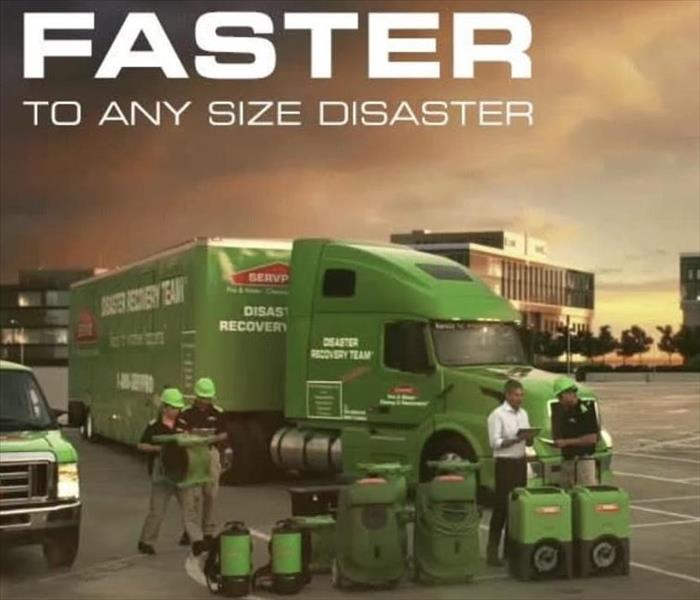 We are locally owned and operated and can mobilize fast to any size disaster
We are locally owned and operated and can mobilize fast to any size disaster
Floods, tropical storms, tornadoes, hurricanes and even severe thunderstorms, can cause extensive damage to homes and businesses. When a natural disaster occurs, most companies that respond to storm damage are unable to handle the damage when it's wide-spread. We have the resources to handle massive severe weather events, no disaster is too big. We can access resources from a network of 1,700 franchises across the country and elite Disaster Recovery Teams strategically located throughout the country. As part of a Large Loss Recovery Team, our efforts have protected many of the apartments and buildings throughout our area of Manhattan, but also helped those affected by considerable storm systems such as Hurricanes Katrina and Sandy.
Our staff are highly trained Storm Damage Specialists. Our training program include the following:
- IICRC Trained and Certified
- Employee Certification Training
- Initial Franchise Training
- e-learnings
- Continuing Education Classes
Why SERVPRO of Upper East Side?
- A Trusted Leader in the Storm and Water Restoration Industry.
- Faster to any size disaster.
- Faster to any size emergency.
- No job too large.
- Catastrophic storm and major event response.
- Every large loss is supervised by a commercial operations manager to help ensure seamless communication and timely mitigation.
- Our ability to dispatch trained production professionals.
- We cut costs through the strategic placement and oversight of temporary labor.
- 24-hour emergency services
- Ready to help 24/7/365
We're a locally owned company with natural resources. We are proud to be a part of our community and strive to provide the residents and business owners in our area the fastest response times and our best work each and every day.
Have Storm or Flood Damage?
Call Us Today (917) 924-2260
Know what your homeowners insurance policy covers!
2/12/2024 (Permalink)
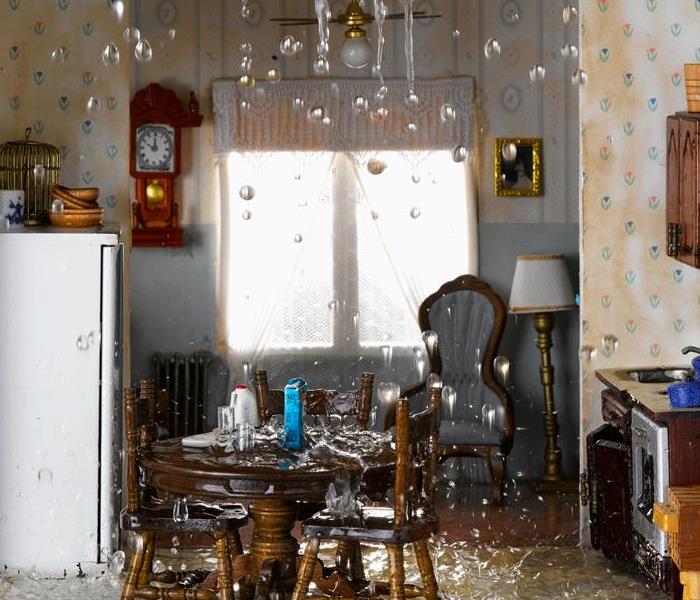 Immediate action is crucial when dealing with water damage.
Immediate action is crucial when dealing with water damage.
Pipe leaking under the sink can create water damage
Most homeowners insurance policies help cover water damage if the cause is sudden and accidental. Homeowners insurance may help pay for repairs if for instance, your drywall is wet after your water heater ruptures or if an upstairs pipe bursts and water saturates the ceiling below.
Depending on the damage, two types of coverage within a homeowners insurance policy may apply.
Dwelling Coverage
Dwelling Coverage helps pay for damage to the structure of your home if it's damaged by a covered peril. So, if a pipe suddenly bursts and damages a wall, dwelling coverage may help pay for repairs.
Personal Property Coverage
Personal Property Coverage helps pay for damage to your belongings if they are damaged by a covered risk. So, if a pipe bursts and results in water damage to your computer or bookcase, personal property coverage may help pay to repair or replace the damaged items.
Keep in mind that a deductible will likely apply before your coverage kicks in. Also, coverage limits may apply. Read your policy to find out how much coverage you have. Your agent can help you adjust your coverage to fit your needs or answer questions about your policy.
DOES HOMEOWNERS INSURANCE COVER WATER DAMAGE FROM LEAKING PLUMBING?
Homeowners insurance may help cover damage caused by leaking plumbing if the leak is sudden and accidental, such as if a washing machine supply hose suddenly breaks or a pipe bursts. However, homeowners insurance does not cover damage resulting from poor maintenance. So, if damage results after you fail to repair a leaky toilet, for example, homeowners insurance likely will not pay for repairs.
WHAT TYPES OF WATER DAMAGE ARE NOT COVERED?
Homeowners insurance does not cover certain types of water damage.
Damage from Unresolved Maintenance Issues
Your homeowners insurance will probably help cover the cost of replacing or repairing a damaged floor, if your dishwasher malfunctions and causes a flood. Be aware that coverage generally will not kick in if the damage results from an unresolved maintenance issue, such as continuous leaking near a faucet or other plumbing fixture.
Replacing or Repairing the Source of the Water Damage
Most homeowners insurance policies will not cover the source of the water damage. So, while your policy may cover the cost of tearing out and replacing that damaged floor, you shouldn't expect it to cover the cost of replacing your broken dishwasher or washing machine.
Water Backup from an Outside Sewer or Drain
You also will not typically be covered by a traditional homeowners policy if water backs into your home through an outside sewer or drain. You may, however, be able to purchase additional sewer or water backup coverage that may help cover damage from that type of event.
Flood
No type of flood damage, no matter the source of the water, is covered by standard homeowners policies. Flooding, for example, can occur from storms, over-saturated ground, overflowing or surging bodies of water such as rivers, ponds, lakes and oceans. You may be able to purchase a separate flood insurance policy through the National Flood Insurance Program.
While it's important to keep up with home maintenance to help prevent damage from water, it's also a good idea to check with your agent about what is and is not covered by your homeowners policy. Be sure to inquire about any additional coverages that may be available to you.
4 Steps To Deal With The Aftermath of Water Damage
7/28/2022 (Permalink)
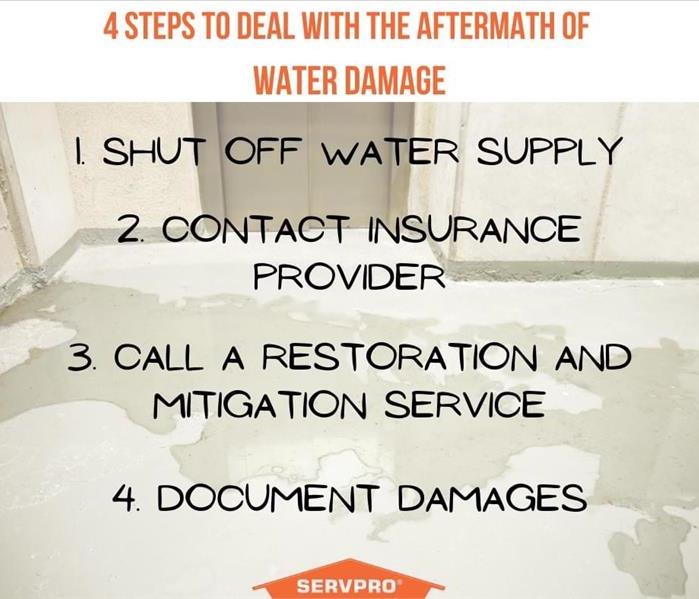 FIrst 4 immediate steps to take if you have Water Damage
FIrst 4 immediate steps to take if you have Water Damage
No homeowner wants to deal with a flood in their home, but having a plan of action in place will help take at least a little stress out of the situation.
If you ever experience a major water leak in your home, here are the steps to follow:
1.) Shut Off the Water Source
First and foremost, if you discover a major water leak in your home, you need to stop the flow of water. By doing this immediately, you may be able to prevent more damage from happening to your home. If you can easily identify the leak source and it has a shut off valve available, you may be able to simply turn off the water at that source.
2.) Contact Your Insurance Agent
After you have made sure no more water is getting in to the home, it’s time to call your insurance agent. There is a small chance you won’t want to file a claim for the damage, but that is highly unlikely. If your baseboards or walls have gotten wet, they need to be professionally dried out to prevent mold from growing in your walls, and that process can be thousands of dollars. You may want to describe what you are seeing to your agent and see if she recommends you start the claim process based on your deductible, but most times that answer is going to be a quick yes.
3.) Contact the Restoration Company
As soon as you get off the phone with your insurance agent, call the restoration company. If they are a good company, they should be able to get a team there within a couple hours to start removing water from the home. Mold can start growing very quickly.
4.) Document the Damage
When the restoration company arrives, they will likely show up with big trucks with lots of hoses and industrial vacuums to remove the water from the tile floors. If you have carpet, they will likely start tearing it out. They will probably start tearing off baseboards and door frames, and depending on how much saturation the water was able to do, they could start removing pieces of drywall and even cabinets.
APRIL SHOWERS COULD RESULT IN WATER DAMAGE
4/28/2020 (Permalink)
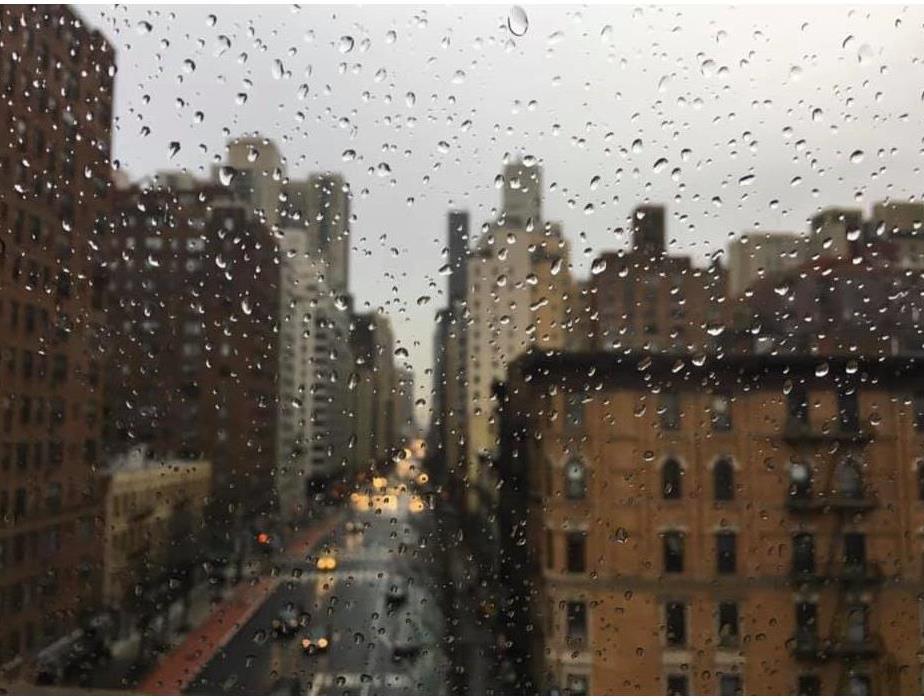 Rainy day in New York City
Rainy day in New York City
Statistically speaking, April is not the rainiest month, but rainfall is more frequent in April. More rain increases the chance of water entering your home or business and causing damage. The most common and destructive type of water damage is most often rain related. Some of the more common ways rain can enter, is through cracks in basement walls, from around windows and doors or from a roof leak. Once moisture enters, mold is sure to follow if immediate action is not taken. It's very important to respond to these emergencies promptly, so we can increase the chances of restoring what has been damaged as opposed to replacing which can be costly. Our response team at SERVPRO of Upper East Side is available 24/7 to provide you with exceptional service. We will arrive fully prepared with our extraction and drying equipment and do all we can to make it "Like it never even happened."
Is There Water Damage in Your Manhattan High Rise?
4/29/2019 (Permalink)
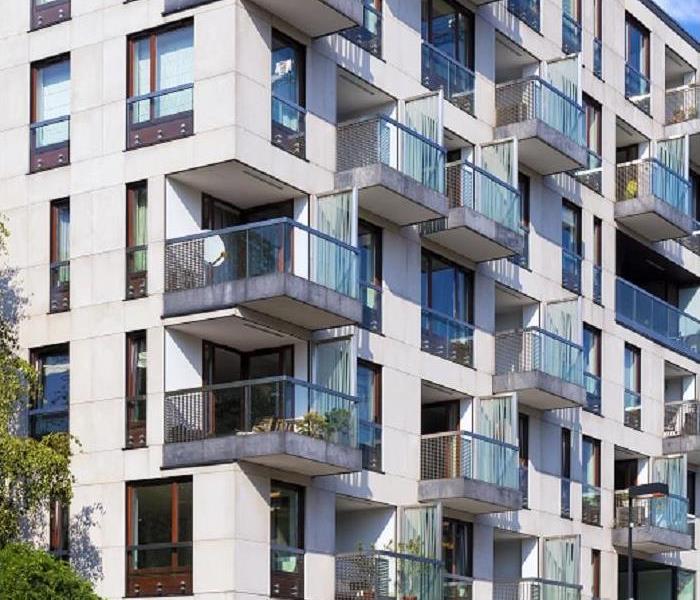 What is the best way to restore a water damaged high rise? Call SERVPRO!
What is the best way to restore a water damaged high rise? Call SERVPRO!
Protecting Your High-Rise Manhattan Apartment from Water Damages
Water loss incidents that can occur in the high rises lining the eastern side of Central Park in Manhattan and throughout the blocks beyond it can be incredibly damaging to the building. Regardless of the source of this incident, the effects can spread through joined walls to affect multiple units simultaneously, not to mention, spread throughout the entirety of the initially affected apartment. Addressing the effects of a water loss incident must occur quickly to prevent unnecessary demolition and reconstruction and to prevent the spread of these effects further through the building.
Water damage in your Manhattan high rise apartment can come in multiple layers, stretching far beyond exposure to the structural elements and construction materials. Understanding the full impact of water saturation and secondary effects that could occur can help to encourage property owners to respond to these emergencies quickly by reaching out to the 24/7 SERVPRO response team that remains prepared to handle the full spread of these effects. We approach these situations with advanced machines and tools and a roster of IICRC-certified Water Restoration and Applied Structural Drying Technicians.
One of the most pressing effects of water loss incidents is the saturation of construction materials and structural elements. The longer drywall, flooring, and other components can remain saturated, the more likely that they become irreparably damaged or unsalvageable when restoration work begins. Addressing these concerns begins with a thorough inspection of the affected elements by our SERVPRO estimator and management.
We can arrive with the full measure of our extraction and drying equipment, helping us to get started immediately on protecting and preserving the portions of your property that we can. We understand how quickly these effects can spread to neighboring units, so we work to install as many high-velocity air movers and dehumidifiers as are necessary to completely prevent the spread of effects and begin efficiently removing moisture from structural components.
While there are multiple layers to the damage that water can do in your high-rise apartment, our SERVPRO of Upper East Side can help. Let us show you how we can make water loss incidents “Like it never even happened.” Give us a call anytime at (917) 924-2260.
Read more about things to see in Manhattan here.

 24/7 Emergency Service
24/7 Emergency Service


